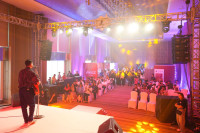Culture & Lifestyle
Nepal is still unfriendly to its queer citizens
Queerphobia is not visible because queerness is not a topic of consideration, let alone conversation.
Birat Bijay Ojha
Every Saturday evening, Pink Tiffany, an LGBTQIA+ friendly restaurant and bar in Thamel, slowly fills up with people from the community. Eventually, it gets a little too crammed. This shows there aren’t many spaces in Nepal for queer folks to be themselves and have a good time.
Besides the restaurant, the other queer-friendly spaces are just the organisations that work for PoMSOGIESC (people of marginalised sexual orientation, gender identity and sex characteristics). Despite all these limitations, the queer community in Nepal has come a long way. The Supreme Court verdict of 2007 implemented laws for the protection and rights of the PoMSOGIESC. It seems progressive on paper, but the socio-cultural shift is yet to occur.
The fact that the capital city—which is considered more open-minded—lacks spaces for the community paints a grim picture of how difficult the situation of queer individuals in rural areas might be like.
I often hear that Nepal is a queer-friendly country, but most of the time, it is always from someone who is a straight passing queer person or a straight person who says so because they have queer friends. We fail to consider that perhaps queerphobia is not visible because our society is so terrifyingly heteronormative that queerness never becomes a topic of consideration, let alone conversation.
However, queerphobia exists, but most queerphobia-rooted hate crimes do not get the attention of mainstream media. And those that do eventually get dismissed, and queer folks are blamed for being over the top or flaunting their sexuality and gender identity.
How can we say Nepal is a queer-friendly country when our laws are still regressive? The ‘other’ categorisation introduced by the government is outdated. Sex, gender and sexuality, the three different categories, dissimilar from one another, get boxed into one label. In addition to the division, the systems disproportionately exclude gender and sexual minorities such as trans, non-binary and gender-diverse individuals.
Let’s take the example of Rukshana Kapali—a familiar name in the queer community. She has been fighting for her gender identity for a decade. But with its regressive laws, Nepal has done irreparable damage in her case. Just think about the many hours, days, months and years she has spent attempting to get a legal identity as a transgender woman.
Recently, Kapali even wrote about the mental toll this took on her on Twitter. It has been years since she came out. Why is it taking so embarrassingly long for the country to accept her identity as a transgender woman?
The narrative of Nepal being queer-friendly is a misconception. Conversations around the topic never even reach the general masses—the dinner table or tea shops. Most of the population doesn’t even know what queer means.
We have to realise that Kathmandu does not represent the entire nation. The privileged folks from the capital who live in a bubble cannot speak for the PoMSOGIESC of the country. Cisgendered straight folks create panel discussions only to invite queer people and ask them to educate them on the basic queer stuff, which can be more than quickly done with some research.
Shuby Bhattarai, a non-binary queer person, says Nepal isn’t as inclusive as the media portrays. “I have faced microaggressions in medical and office settings due to my tomboyish looks,” shares Bhattarai. They are one of the many trans individuals who want to change their name, but the existing legal provisions make it difficult and complicated to do so. Similarly, the information gap on queer support and services in government settings creates more hassles in seeking guidance.
“Queerphobia should be our collective fight, whether they exist in the form of violence or microaggression,” says psychological counsellor Manita Newa Khadgi. “We should acknowledge the existence of our conscious, unconscious biases, and exclusionary behaviours towards those with queer identities.”
Khadgi founded Nepali Asexuals and Aromantics, the first official collective of asexuals and aromantics of the country. The collective fights against aphobia (discrimination against asexuals and aromantics). She reveals that asexuals like her have experienced feeling invisible—be it intentionally or unintentionally—even by individuals who claim to be informed about the queer community.
Khadgi believes it is imperative to be mindful of nuances regarding individuals who belong to the queer community. “We must understand that the human experience of gender and sexuality is dynamic and ever-evolving,” she says. We should celebrate and not just tolerate gender identities and sexual orientation and sex characteristics different from ours, she says.
While the state remains unfriendly to the queer community, individuals can and should be allies. However, the solidarity should not just be limited to straight-passing queer folks. It should extend to trans, intersex, asexuals, aromantics and other gender and sexual minorities, even if their expressions are a bit too feminine, flamboyant or so ‘over-the-top’ that it makes you uncomfortable.




 7.12°C Kathmandu
7.12°C Kathmandu













%20(1).jpg&w=300&height=200)

